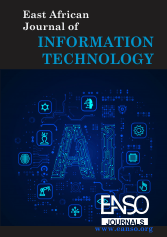Analysis of Urban Green Spaces Using Support Vector Machine in Urban West Region of Zanzibar
Abstract
Integrating remote sensing techniques with Machine learning-based methods is crucial for analyzing land spatial structures. This study employs the Support Vector Machine to analyze Urban Green Space in the Urban West Region of Zanzibar. The analysis focused on evaluating Support Vector Machine performance in remote sensing imagery classification, assessing green landscape connectivity, and examining geospatial green change trends over 10 10-year periods. The findings revealed that the accuracies of the Support Vector Machine classification exceeded 0.9, making it suitable for further analysis. Thematic maps generated from the study visualize low green connectivity with poor spatial patterns of green patches in the west of the Urban West Region, primarily due to the higher density of buildup areas. The analysis also indicates the absence of green corridors to enhance connectivity between the patches. Additionally, approximately 0.019% of green area coverage was lost between 2009 and 2018, attributed to shoreline damage along the coastal zone of the eastern side of the Urban West Region. The transition of green spaces, such as trees, shrubs, and grass, into low-density buildup areas and, subsequently, into high-density buildup areas was significant. This transformation poses potential challenges, including increased air pollution and mental health concerns. To address the green challenge issues, the Urban Municipalities of Zanzibar must implement robust strategic plans to preserve and enhance Urban Green Space; such initiatives are essential for promoting sustainable urban development in Zanzibar and mitigating the adverse effects of urbanization on green spaces and overall environmental quality.
Downloads
References
Abbas, Z., & Jaber, H. S. (2020). Accuracy assessment of supervised classification methods for extraction of land use maps using remote sensing and GIS techniques. IOP Conference Series: Materials Science and Engineering, 745(1), 012166. https://doi.org/10.1088/1757-899X/745/1/012166
Azwar, D. H., & Ghani, I. (2014). The importance of green space: Towards a quality living environment in urban areas. Journal of Architectural Research, ArchNet-IJAR, 3(1), 267. https://doi.org/10.26687/archnet-ijar.v3i1.267
Cetin, M. (2015). Using GIS analysis to assess urban green space in terms of accessibility: A case study in Kutahya. International Journal of Sustainable Development and World Ecology, 1– 5. https://doi.org/10.1080/13504509.2015.1061066
Haaland, H., & van den Bosch, C. K. (2015). Challenges and strategies for urban green-space planning in cities undergoing densification: A review. Urban Forestry & Urban Greening, 14(4), 760–771. https://doi.org/10.1016/j.ufug.2015.07.009
Hyseni, C., Heino, J., Bini, L. M., Bjelke, U., & Johansson, F. (2021). The importance of blue and green landscape connectivity for biodiversity in urban ponds. Basic and Applied Ecology, 57, 129–145. https://doi.org/10.1016/j.baae.2021.10.004
Jung, M. (2013). LecoS-A QGIS plugin to conduct landscape ecology statistics. PeerJ Preprints. https://doi.org/10.7287/peerj.preprints.116v2
Khati, R., & Acharya, T. (2021). Deep learning in land cover classification. International Journal of Engineering Research, 4, 32–38.
Kranjčić, N., Medak, D., Župan, R., & Rezo, M. (2019). Machine learning methods for classification of green infrastructure in city areas. ISPRS International Journal of Geo-Information, 8(10), 463. https://doi.org/10.3390/ijgi8100463
Landis, J. R., & Koch, G. G. (1977). The measurement of observer agreement for categorical data. Biometrics, 33(1), 159–174. https://doi.org/10.2307/2529310
Lee, A. K., Jordan, H., & Horsley, J. (2015). Value of urban green spaces in promoting healthy living and wellbeing: Prospects for planning. Risk Management and Healthcare Policy, 8, 131– 137. https://doi.org/10.2147/RMHP.S61654
Lee, A. K., & Maheswaran, R. (2011). The health benefits of urban green spaces: A review of the evidence. Journal of Public Health (Bangkok), 33(2), 212–222. https://doi.org/10.1093/pubmed/fdq068
Mattsson, A., & Möllerström, M. (2014). Urbanization and density in Zanzibar. Bachelor Thesis, The State University of Zanzibar.
Mensah, C. A. (2014). Destruction of urban green spaces: A problem beyond urbanization in Kumasi City (Ghana). American Journal of Environmental Protection, 3(1). https://doi.org/10.11648/j.ajep.20140301.11
Omar, H., & Cabral, P. (2020). Ecological risk assessment based on land cover changes: A case of Zanzibar (Tanzania). Remote Sensing, 12(19), 3114. https://doi.org/10.3390/RS12193114
Peschardt, K. (2012). Use of small public urban green spaces. Urban Forestry & Urban Greening, 11(3), 235–244.
Public Health England (PHE). (2014). Improving access to green spaces. Health Equity Brief, 8(September).
Rudrapal, D., & Subhedar, M. (2015). Land cover classification using support vector machine. International Journal of Engineering Research, 4(9). https://doi.org/10.17577/IJERTV4IS090611
Taylor, L., & Hochuli, D. F. (2017). Defining greenspace: Multiple uses across multiple disciplines. Landscape and Urban Planning, 158, 25– 38. https://doi.org/10.1016/j.landurbplan.2016.09.024
Wessel, M., Brandmeier, M., & Tiede, D. (2018). Evaluation of different machine learning algorithms for scalable classification of tree types and tree species based on Sentinel-2 data. Remote Sensing, 10(9), 1419. https://doi.org/10.3390/rs10091419
Yadav, A., & Dodamani, B. M. (2019). Shoreline change: A review. March, 2019.
Copyright (c) 2025 Asha Hamad, Yahya Hamad Sheikh, PhD, Abubakar Diwani Bakari, PhD

This work is licensed under a Creative Commons Attribution 4.0 International License.




























